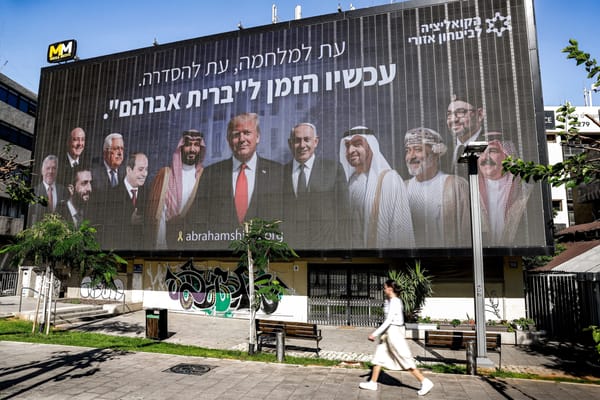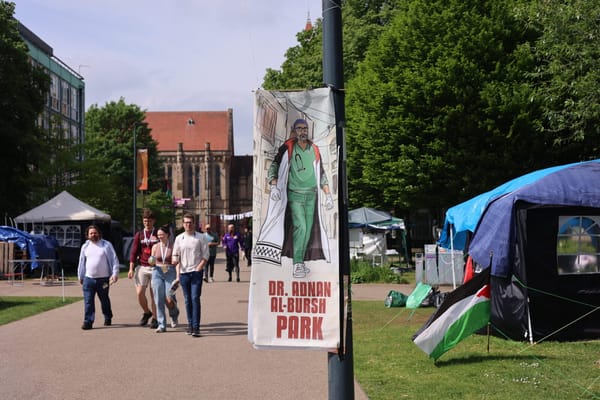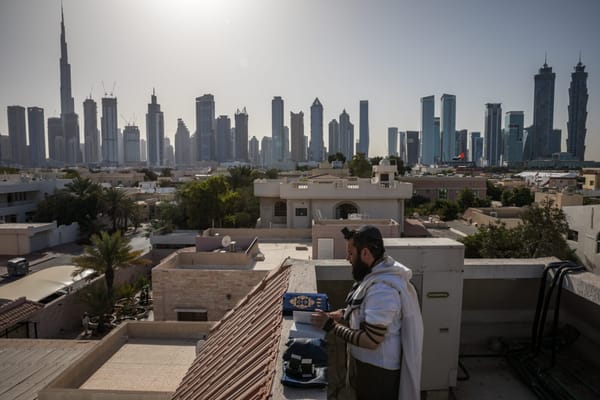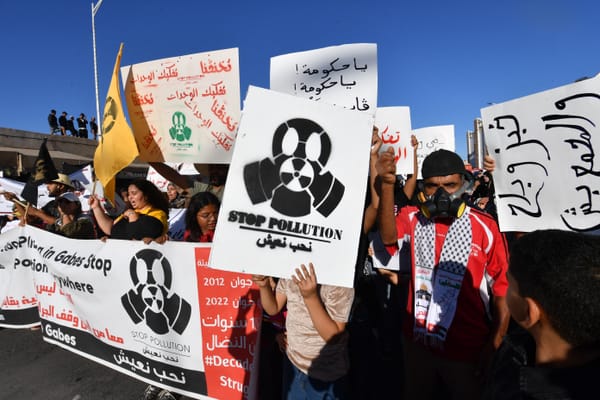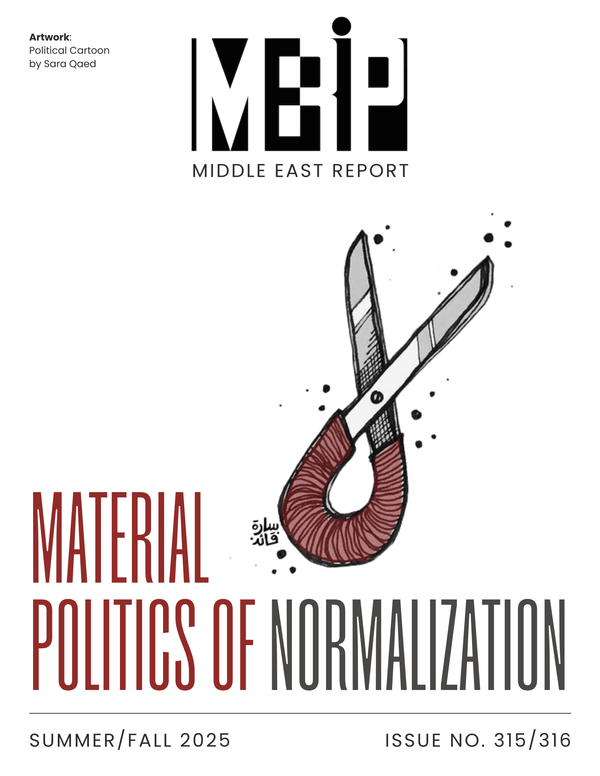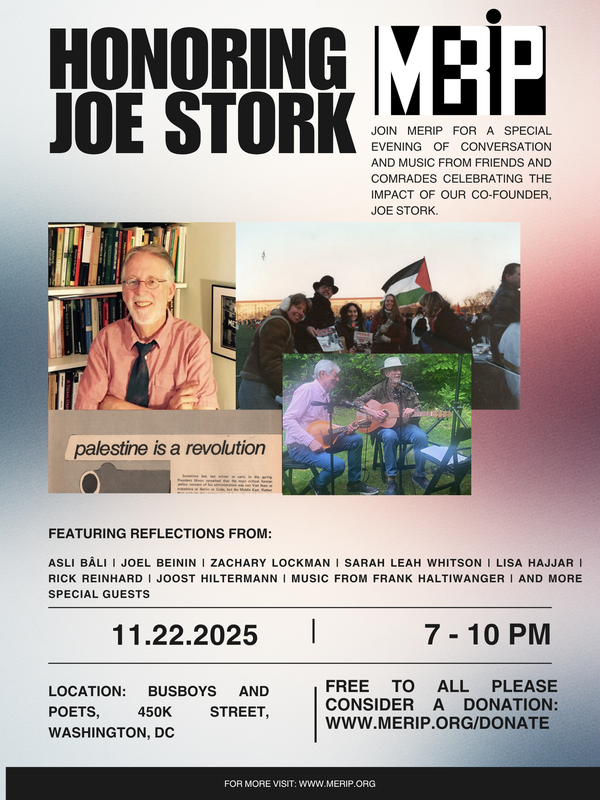On the Road to Rafah—The Sumud Convoy and New Maghrebi Geographies of Resistance
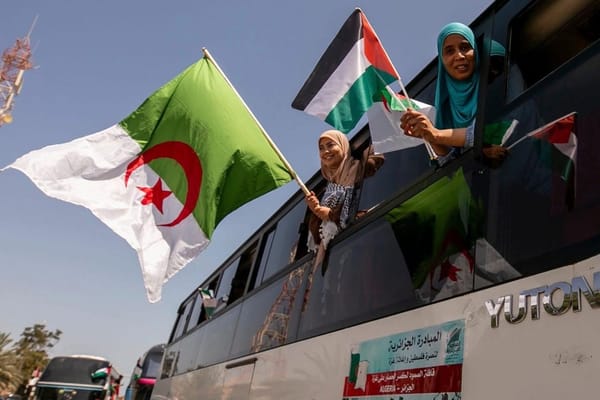

When the last bus came to a halt in Sirte, a coastal city in Central Libya, many thought it marked the end of the road.
But it was only a turning point. What began as the Sumud Convoy—a historic act of Maghrebi solidarity with Palestine—had already transformed into something more: a living, popular geography of solidarity, tracing new lines of resistance for Palestine.
The Convoy had first set out on June 9, 2025, carrying more than 1,700 Tunisians, Algerians, Libyans, Mauritanians and Moroccans. Born from the ground up, it brought together activists, organizers, artists, medics, students and ordinary citizens—all prepared to face repression. They mobilized not only to break Israel’s blockade of the enclave but also to challenge their own governments, whose complicity and silence helped normalize the genocidal siege on Gaza. Launched by the Tunisian Coordination for Joint Action Palestine, Algerian and Libyan civil society actors soon joined, lending the initiative a truly regional scope. Its route followed the Tunisian coast south before cutting east across Libya, tracing the shoreline toward Egypt and, ultimately, the Rafah crossing into Gaza.
Inside the buses, chants blended poetry, prayer and protest, weaving familiar refrains with reinvented slogans and spontaneous creations. Participants also spoke through gestures—raised fists, waving flags, keffiyehs wrapped around heads and necks. “The keffiyeh we wear is our banner—woven of earth and blood, it speaks louder than a thousand false speeches by Arab leaders,” said one Tunisian activist in the convoy.
Alongside the Sumud Convoy, the Madleen Flotilla—part of the long-standing Freedom Flotilla Coalition that, since 2010, has organized maritime attempts to break the siege of Gaza—had already set sail. And the Global March for Gaza, a transnational mobilization seeking to converge on Gaza’s borders, prepared to coordinate a collective arrival in Cairo en route to Rafah. Over the summer, Tunis emerged as a key political and coordinating center where these three initiatives met, shifting the center of Palestinian solidarity toward the Global South.
The Sumud Convoy’s journey traced this convergence on the ground. What began as an act of material solidarity through the delivery of vital humanitarian aid quickly became a site of political confrontation with both Israel’s blockade and the complicity of North African states. Libya’s territorial fragmentation functioned as an active instrument of repression. At Sirte, these two competing material geographies—solidarity from below and repression from above—met.
The Sumud initiative had been quietly taking shape since the start of 2025. Volunteers worked out of the spotlight, sorting legal papers, mapping routes, stockpiling supplies and keeping communications alive. Two discreet sites in Tunis became nerve centers stacked with boxes and coiled extension cords, echoing with the shuffle of feet. On the eve of departure, a warm Tunis night, the atmosphere crackled with energy: Chains of humans ferried crates from hand to hand—young and old, women and men, working side by side. Donations had flooded in, including bundles of banknotes, sacks of couscous, piles of blankets. By midnight, the last vans were packed tight ready to carry the convoy toward Gaza.
The mission was unambiguous: to reach Rafah and to break Gaza’s isolation through the sheer force of our collective physical presence.
At first light on June 9, a column of buses, vans and cars began to roll out of downtown Tunis. Hundreds waited for a seat without tents or chairs. Buses brought in from Algeria were parked in a long line, their drivers patiently ushering in passengers. The mission was unambiguous: to reach Rafah and to break Gaza’s isolation through the sheer force of our collective physical presence. The caravan continued through the Tunisian regions of the Sahel and far coastal south and was welcomed at each stop by visible expressions of support.
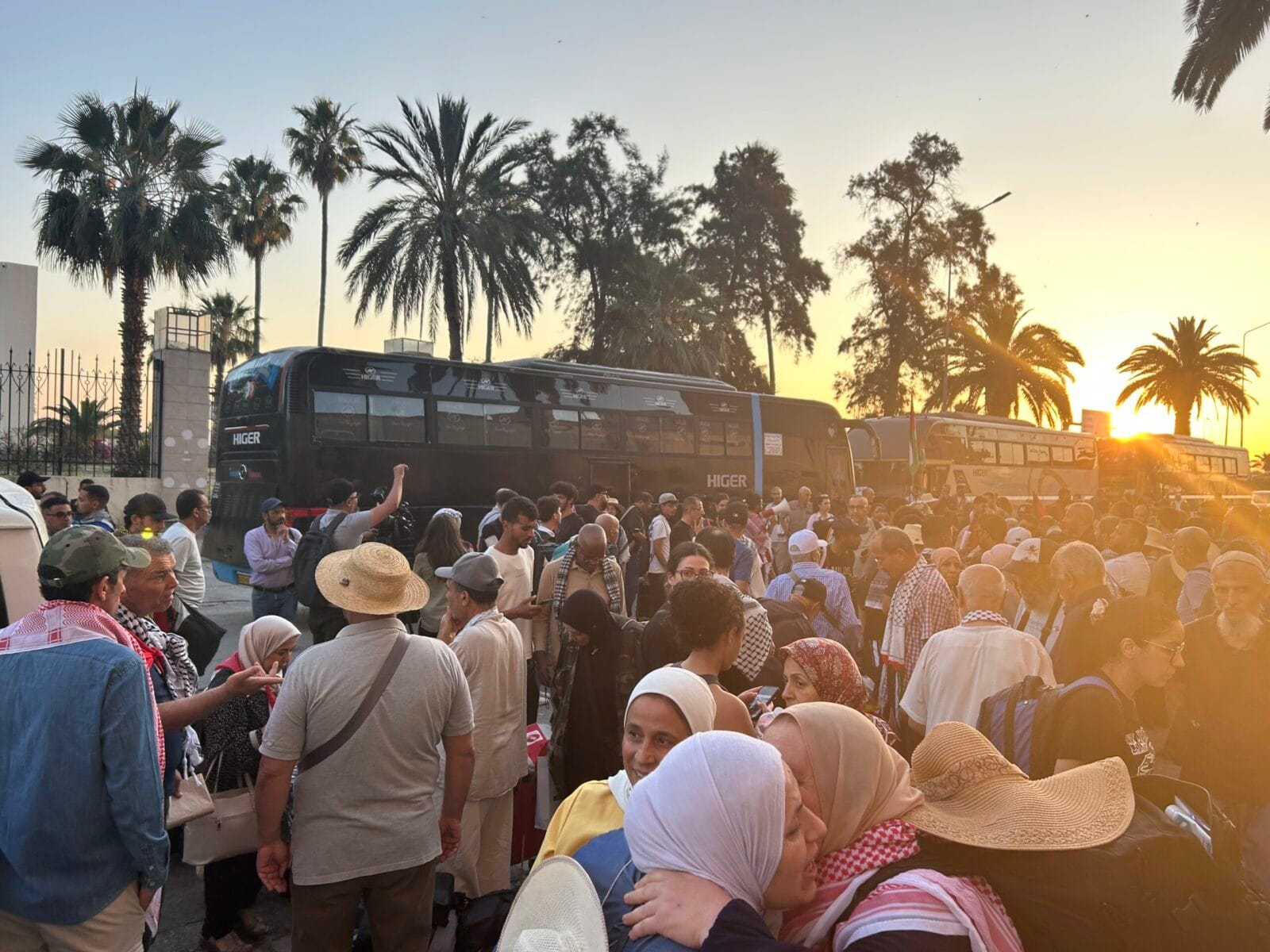
In areas of western Libya under the authority of the Government of National Unity, local officials and residents alike received the convoy positively. People gathered along the roadside in Zliten and later Misrata, offering water bottles and, at times, small sums of money to participants.
Despite the persistent political fragmentation in Libya, the hospitality extended to the convoy carried both symbolic and logistical weight. According to participants interviewed, the Libyan delegation in western Libya made significant efforts to ensure the group’s safety and well-being. “Everything was taken care of by the people. This solidarity shows me we are truly brothers. I’ve never seen anything like it,” said Karim, a young Algerian participant.
Local radio and social media publicized the initiative. Schools were opened for lodging while some residents hosted participants in their homes and organized field kitchens. This community-based logistical support allowed the convoy to function independently of formal state structures.
On June 13, however, the warm welcome gave way to hostility as the convoy left Misrata and approached Sirte. The coastal city is under the control of forces loyal to Field Marshal Khalifa Haftar, the Egyptian- and Emirati-backed strongman of eastern and southern Libya. A few kilometers from the city’s entrance, the caravan was halted by armed men affiliated with Haftar. For three days, hundreds of participants were stranded in the desert, exposed to heat and surveillance, cut off from journalists, aid and communication.
Citing “security,” Haftar’s forces interrogated and beat some of the organizers, confiscating supplies. Activists were exposed to targeted harassment, silent pressure and arbitrary arrests. “We were abandoned on the side of a desert road—no trees, no shops, no shade, not even toilets,” recalled Marwen, coordinator of the Algerian delegation. “Older participants lay under the buses to avoid collapsing. Several people could have died.”
This sudden reversal of fortunes exposed not only Libya’s internal divisions but also the regionally coordinated repression sustaining the authoritarian management of transnational mobilizations. Each section of Libyan territory is governed by its own security logic. In Sirte, it was that of Haftar’s camp, which has developed ties with Israel through the mediation of the UAE. According to media reports, Haftar’s sons have held meetings with Israeli officials in Abu Dhabi and there has been security and surveillance coordination between them.
Libyan and Maghrebi activists suggest the blockade near Sirte was part of a broader strategy shared by Egypt, the Emirates and Israel, to suppress any initiatives on Palestine outside of their control.
Libyan and Maghrebi activists suggest the blockade near Sirte was part of a broader strategy shared by Egypt, the Emirates and Israel, to suppress any initiatives on Palestine outside of their control. The convoy—by posing a direct challenge to the regional geography of complicity and repression surrounding Gaza—demanded repression. It often took the form of targeting visible activists and movement leaders.
Wael Naouar, a leader of the Sumud Convoy was kidnapped in Sirte and brought to Benghazi, while Saif Abu Keshek, a Palestinian activist and one of the leaders of the Global March to Gaza, was kidnapped and deported out of Egypt. Haftar’s local and anti-terrorist forces arbitrarily arrested at least 15 Algerian, Tunisian and Libyan activists—including social media influencers Ala Ben Amara, Bilal Ourtani and Zidane “Zizou” Nezar—after they had peeled off from the convoy to seek communication access. Separated from the group, they were denied legal recourse and dispossessed of belongings. Some were threatened at gunpoint.
In the face of this repression, the convoy decided to make a tactical retreat to Misrata, where it was again met with hospitality. Regrouping, the Sumud participants held firm to a conscious strategy of confrontation. As one Tunisian participant put it, “Our suffering is nothing compared to what Palestinians are going through.” His words reframed pain from a humanitarian register to an ethical and political one.
Unable to advance physically, the convoy advanced politically. To break through the media blackout, the movement turned to alternative forms of visibility—social media and livestreams—to circulate their testimonies. Their messaging redefined Gaza’s geography not as a distant tragedy but as a frontline of regional contestation: Rafah’s inaccessibility became a spotlight on the wall of impunity and normalization shielding Arab regimes. The convoy’s greatest vulnerability, its immobilization, was transformed into a weapon of accusation and exposure in the hands of Sumud’s activists.
The events of summer 2025 marked the point where more than a decade of parallel activist dynamics began to converge, transforming long-separate efforts into a shared front.
The Sumud Convoy was rooted in North Africa’s post-2011 Hirak civic landscapes: the Tunisian and Libyan uprisings of 2011, Morocco’s February 20 movement and Rif protests and the Algerian Hirak of 2019. The Freedom Flotilla Coalition, meanwhile, was the product of a decade of international grassroots maritime campaigns to break Israel’s siege on Gaza. And the Global March for Gaza was a mobilization spanning Latin America, South Asia and parts of West Africa. Each carried its own trajectory, logistical culture and political sensibilities. They were united by a shared urgency around Gaza and the conviction that physical presence matters in the face of genocide. While digital visibility through social media amplified the initiatives and helped them to reach global audiences, participants stressed that material presence—buses, boats, marches—carried a political force that could not be replaced by the immateriality of online gestures or “slacktivism.”
This convergence was not forged at international summits or NGO roundtables but through grassroots linkages, improvised coordination and the pressure of shared constraints. Though communication was often unstable, disrupted by geography and surveillance, a flexible coordination system took shape in the months leading up to the convoy. Online platforms, such as Signal, allowed activists to synchronize transregional actions, while shared databases emerged to track routes or accommodation. Local collectives stepped in for translation, legal advice and to protect technological devices from malware intrusions.
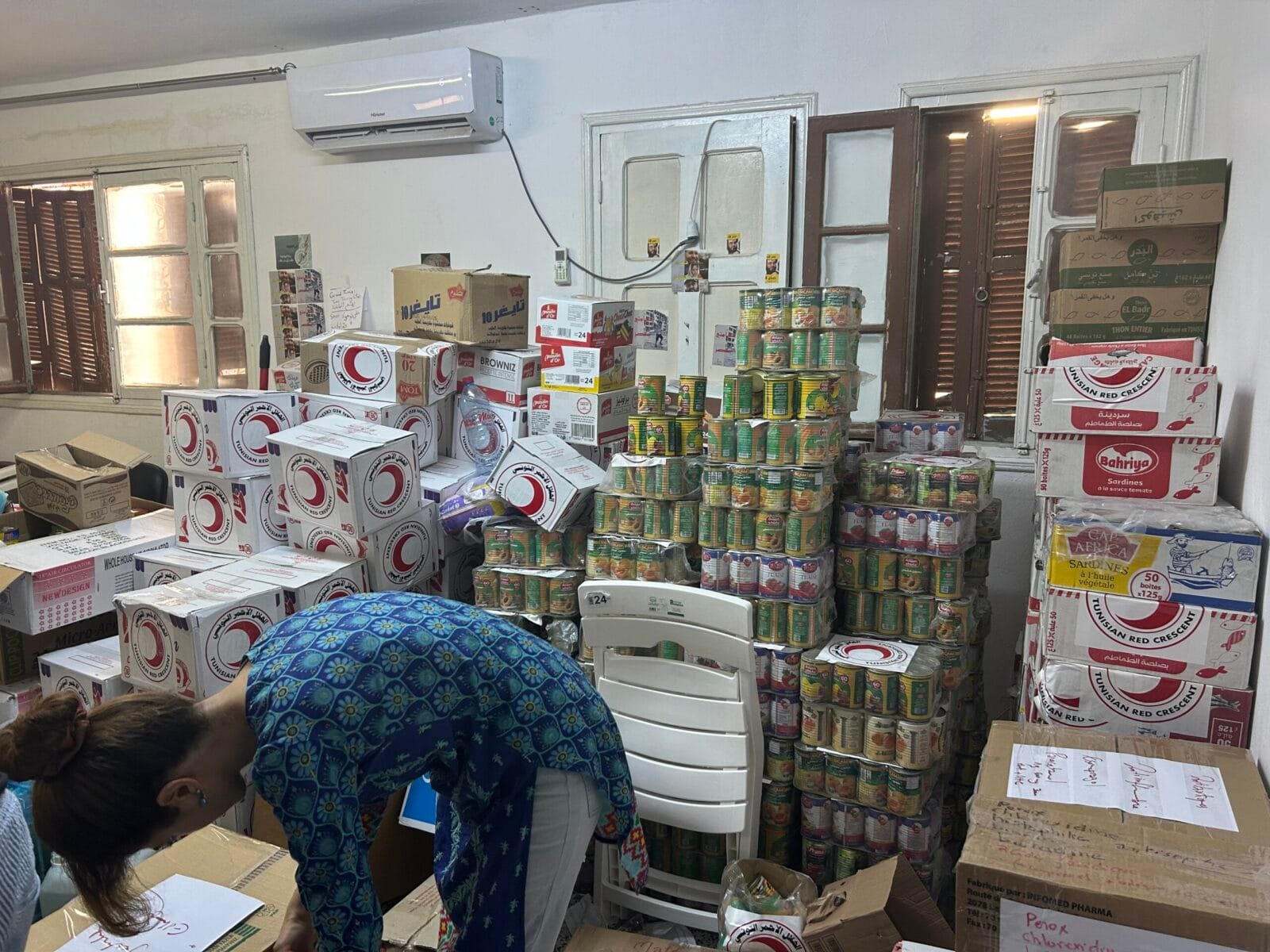
Material solidarity was not a metaphor. During the mobilizations for Gaza, it meant improvised meals, collective first-aid kits, solar-charged communication devices and overstuffed backpacks carried across checkpoints. It meant people donating their cars, their savings and their time and taking risks, without NGO labels or diplomatic immunity. Each of the three movements revealed how logistical resistance—the capacity to organize, transport, host and sustain—has become the backbone of contemporary solidarity.
The Sumud Convoy was financed almost entirely through fundraising and donations from unions, student groups, mosques and the support of individuals. Many contributions came in cash, collected in boxes passed from hand to hand or during community events. Local mechanics offered car repair services. Pharmacies discreetly provided medication. In southern Tunisia, entire families prepared couscous meals and bottled water for strangers they would never meet. In Tripoli and Misrata, Libyan hosts converted wedding halls and barns into makeshift shelters.
The Flotilla and the Global March each brought distinct strengths that later converged in the Global Sumud Flotilla. From the Flotilla came the discipline of maritime coordination—safety skills, non-violent trainings, navigation planning and press documentation. From the Global March came models of mass mobilization across continents, including coordination skills and multilingual communication. Together, these material solidarities—of transport, sustenance and mutual protection—formed the living infrastructure that made the Sumud Flotilla possible, linking people, roads and ports into a shared geography of resistance.
Yet they also revealed the vulnerabilities of material solidarity. Political repression, particularly in eastern Libya, targeted not only participants but the very means of movement. SIM cards were confiscated, fuel supplies cut off and local Libyan hosts were threatened. To adapt, organizers went underground, relying on alternative messaging apps, burner phones and unmarked supply caches. What looked disorganized from above was, in fact, a decentralized infrastructure of care and resistance.
The infrastructures of material solidarity forged over the summer inevitably collided with another kind of infrastructure: the border.
The infrastructures of material solidarity forged over the summer inevitably collided with another kind of infrastructure: the border. Not simply a fixed geographic line but an active system of obstruction designed to fragment, delay and contain. Every checkpoint—whether a military outpost, customs station or passport inspection—forms a part of this machinery. Borders, even those thousands of miles from Gaza, are thus embedded in the architecture of the siege.
The convoy itself never reached Rafah. In Egypt, it was stopped before even submitting an entry request. As in Sirte, authorities treated the act of mass solidarity as a destabilizing challenge, blocking it outright. These material geographies of repression rely on collaboration rather than uniform policies: Each authority applies its own methods, yet all converge on the same objective: to prevent popular solidarity from becoming collective action. But what regimes sought to erase through the mesh of territorial and internal borders and the deliberate isolation of activists, instead served as evidence: It is not only Gaza that is besieged, but solidarity itself—and not only by Israel, but by Arab governments against their own people. In the words of one Algerian participant, “The last stop of Sumud will mark the limit of complicity with Israel.”
In this light, the border acted as both a barrier and a theater of indictment. Each halted bus and confiscated document became part of a larger scene where two orders collided: the regime of institutional complicity and a fragile but determined popular internationalism.
The Sumud Convoy’s immobilization on Libya’s roads did not mark the end of a process but a strategic turning point. A new phase emerged from its direct confrontation with the architecture of complicity. Beginning in August 2025, the Global Sumud Flotilla—an international coalition—set out toward Gaza by sea, seeking to break the siege through a route even harder to contain.
The city of Tunis, which had played a catalytic role in the Sumud Convoy, became the launching ground for the Global Flotilla. In late June, following Israel’s detention of Freedom Flotilla activists, the halt of the Sumud Convoy, and the breakup of the Global March, the three movements convened a joint press conference at the headquarters of the Tunisian General Labour Union, with a keynote by Francesca Albanese. The event formalized their coordination.
The Café Biblio’thé in Tunis then hosted several days of debate, including a roundtable by the African Solidarity Group, a Tunis-based collective of activists raising awareness about dynamics across the continent. Participants from different initiatives compared practices, constraints and visions. This local anchoring reinforced Tunis’s role as a hub for Maghrebi solidarity and created a center of gravity for Palestine solidarity in the Global South. By early August, these convergences had set the stage for the Global Sumud Flotilla, announced in Tunis and preparing for its first departures.
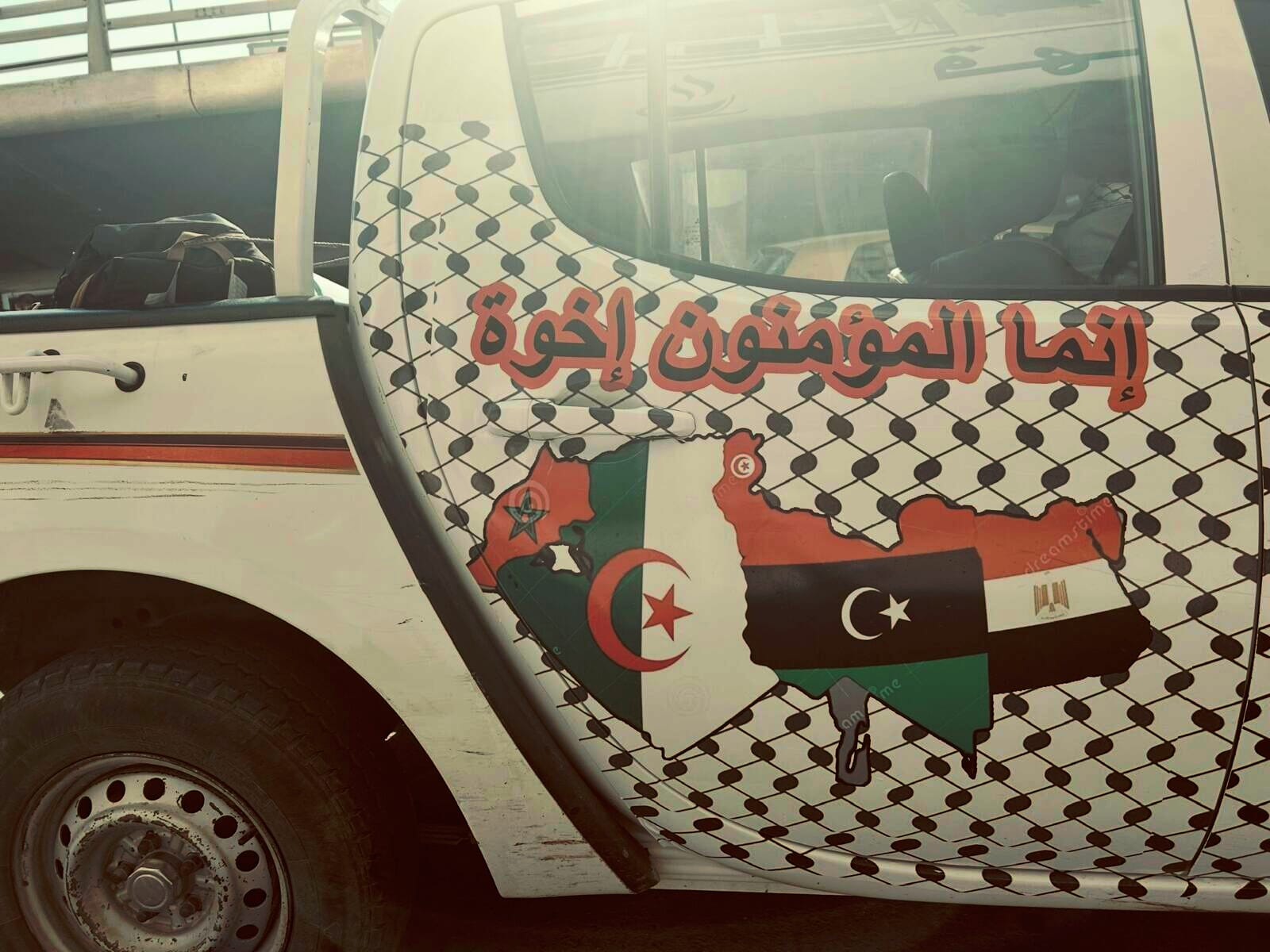
Forged through the lessons of the land journey, this maritime initiative offered a new space of logistical and symbolic confrontation. The new phase was launched from Tunis between August 1–4, 2025, with training sessions, an international press conference and the announcement of sailing dates.
The flotilla docked in Tunisia on September 7, which then became the logistical hub for its Maghrebi and international components. The days that followed were marked by administrative delays, fuel shortages, slow port authorizations and a string of mechanical breakdowns that left more than a dozen locally purchased boats at port. In early September, it was subject to two drone attacks on the port of Tunis that organizers attributed to Israel, and unfavorable weather further slowed preparations. On the nights of September 15–16, around twenty vessels, mainly European ships including the flotilla’s coordinating boat, the Family, finally set sail from Tunisian waters to begin a historic transnational maritime route. Many of the same obstacles persisted through their journey, including constant surveillance, and between October 1 and 3, all 42 boats of the Global Sumud Flotilla were illegally intercepted in international waters while attempting to break Israel’s siege on Gaza. 462 participants were detained by Israel.
Regional power dynamics cannot shift in a matter of months. But the Sumud convoy recentered the geographical gravity of Palestine solidarity: It anchored it in bodies, in buses, in ports, in networks, in mobile phones, in refugee camps and in the streets of Misrata and Zliten. It demonstrated a vision of Palestine no longer reduced to a rallying cry, but reclaimed as a physical site of struggle, one capable of catalyzing new alliances.
More than sustaining bodies, this material support revived political subjectivities worn down by decades of official discourses on Palestine.
The road to Rafah, even when blocked, opened something else: a model for future mobilizations rooted in endurance and humility. More than sustaining bodies, this material support revived political subjectivities worn down by decades of official discourses on Palestine. Preparing food, mapping routes or lending a generator became political acts. Palestine entered the intimate and the everyday, not as a symbol but as a shared condition. These mobilizations built a solidarity infrastructure that challenged the monopoly of institutional humanitarianism. While international aid remains filtered through states and multilateral organizations, grassroots actors created something else that was improvised, horizontal and embodied. They exposed the gap between the abstract language of solidarity and its concrete practice. This solidarity persists in spite of repression and borders, gradually constructing a counter-geography for breaking the siege on Gaza and halting the genocide.
[Raouf Farrah is a writer, analyst and co-founder of Twala.]
Raouf Farrah, "On the Road to Rafah—The Sumud Convoy and New Maghrebi Geographies of Resistance," Middle East Report 315/316 (Summer/Fall 2025).
